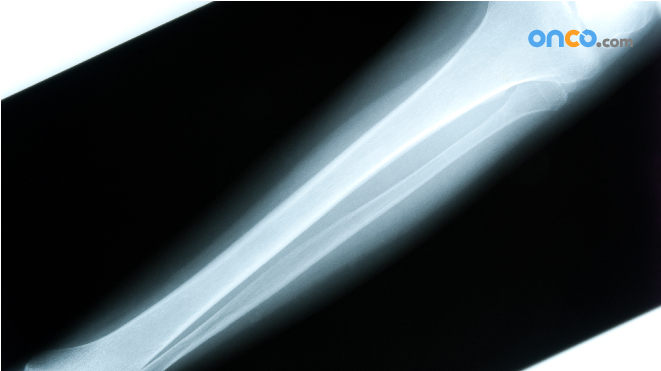When cells in the bone begin to divide uncontrollably, they are called bone cancer. It can affect any bone in the body, but it is common in the thigh bone, knee bone, and other long bones in the body, in children and young adults mostly. The nature of cancer can be suspected based on the type of destruction seen on an X-ray.

Bone cancer may be primary or secondary. The former arise in the cells of the bone while the latter spread from elsewhere. Some quick facts of bone cancers are:
1. Benign bone tumors are more common than malignant bone tumors.
2. There are several different bone cancer types.
3. Early symptoms might include pain in the affected area.
4. A range of diagnostic tests can help diagnose bone cancer.
5. Radiotherapy, chemotherapy, and surgery can all be used to treat bone cancer.
Causes
While doctors are not sure about the precise causes, there may be differences in the reason for the disease from person to person. Majority of people with bone cancers have no history of known risk factors but further research in the field are in progress.
The cause of cancers traces back to DNA mutations (defects) that activate oncogenes or disable tumor suppressor genes. Some people with cancer have inherited DNA mutations, and these increase their risk for certain types of cancers. Genetic testing is a technique to investigate if an individual has one of these mutations. However, most DNA mutations cause some inherited forms of bone cancer. Also read more on other risk factors.
They are a result of mutations during the person’s lifetime. These mutations may stem from exposure to radiation or cancer-causing chemicals, but they occur for no validated reason most times. These mutations are not transferable by genes and are therefore not inherited by children of the individual affected.
What is DNA
DNA comprises units of genes. Genes carry the recipes for making proteins that determine and specify the functions of different kinds of cells. Some genes might have cell growth or division instruction. Genes that promote cell division are called oncogenes. Whereas, genes that slow down cell division or make cells die at the end of their cycle are tumor suppressor genes.
Doctors and scientists have no doubt made leaps in understanding how changes in an individual’s DNA can cause healthy cells to become cancer. DNA carries the instructions for any cell activity. A child’s resemblance to a parent is on account of the genes. Moreover, this may be the reason why some people are prone to developing certain diseases, including some kinds of cancer.
Risk Factors
A risk factor is that which affects one’s chance of getting a disease. The following are the risk factors that involve cancer:
1. People who have received radiation therapy or chemotherapy:
The risk is very negligible. If it does occur, it is usually 10-20 years after having radiotherapy. People previously treated with certain chemotherapy drugs might have an increased risk of developing osteosarcoma.
2. Individuals with non-cancerous (benign) bone tumors:
Paget’s disease of the bone is a benign condition that causes painful and deformed bones. This may increase the risk of developing osteosarcoma and primarily affects people over 60. A non-cancerous bone tumor-like osteochondroma (or chondroma) can sometimes develop into chondrosarcoma.
Also, people with hereditary exostoses (HME) are at a higher risk of developing chondrosarcoma. HME is a rare condition that causes lumps to grow most commonly in the limb bones. Mostly, this condition shows appearance in childhood but not in all cases. It is inherited by people who have a close relative who has bone cancer.
3. Genetic disorders:
People who have inherited a gene that is maladaptive to the bones may run the risk of developing bone cancers. Retinoblastoma is a rare eye cancer that children are susceptible to inheriting. Generally, mutations may result in individuals developing soft tissue sarcomas. Radiation therapy used as a treatment for retinoblastoma increases the risk of osteosarcoma. Despite this, there are examples of non-inherited genes of whose defects there is little information.
4. Bone Marrow Transplant:
Bone marrow transplant is a procedure that removes a diseased part of a bone that has been destroyed by infection or chemotherapy. Besides, there has been an increased risk of developing bone cancers.
Symptoms of Bone Cancer
A symptom is a physical feature apparent to an individual that indicates a condition of the disease. The symptoms of bone cancer are:
- Pain in the affected bone
- Swelling
- Fractures
- Cancer in spinal bones can cause numbness or a tingling sensation
- It may cause weight loss and fatigue
- Spreading to the lungs may cause difficulty in breathing
- Problems during movement
- Other symptoms
Screening Systems:
Imaging tests and blood tests might suggest that a person has bone cancer. In most cases, doctors confirm this through a biopsy, which is a procedure that tests a tissue or cell sample by checking it under a microscope.
Accurate diagnosis of bone tumors include the combination of information on the bone affected, then part of the bone involved, X-rays, and a biopsy. Moreover, other diseases like bone infections can cause symptoms and imaging results that can cause misdiagnosis.
Imaging Tests:
1. X-ray: A diagnostic test that uses invisible electromagnetic energy beams to make images of internal tissues, bones, and organs onto film.
2. Computed tomography scan (also called a CT or CAT scan): This is an imaging test that uses X-rays and a computer to make detailed images of the body. As a result, a CT scan shows details of the bones, muscles, fat, and organs.
3. Magnetic resonance imaging (MRI): A diagnostic procedure that uses a combination of large magnets, radio frequencies, and a computer to make detailed images of organs and structures within the body.
4. Positron emission tomography (PET) scan: An imaging test in which radioactive-tagged glucose (sugar) is injected into the bloodstream. A scanning machine can detect tissues that use glucose more than healthy tissues (such as tumors).
5. Biopsy: A procedure in which tissue samples are removed (with a needle or during surgery) from the body for examination under a microscope. Consequently, it determines if cancer or other abnormal cells are present.
Diagnosis
Usually, doctors use a combination of the following approaches to diagnosing a patient with cancer:
1. Physical Examination: Generally, doctors inspect lumps in the body and look for abnormalities.
2. Laboratory Tests: Urine and blood tests help identify defects due to cancer.
3. Imaging tests: Imaging tests used in diagnosing cancer may include computerized tomography (CT) scan, bone scan, magnetic resonance imaging (MRI), positron emission tomography (PET) scan, ultrasound, and X-ray, among others.
4. Biopsy: Samples of cells are collected and viewed under a microscope lens. This usually depends on where the cancer is in the bones. While healthy cells look uniform and equally sized, cancer cells vary in sizes without apparent organization.
Treatment
Treatment of different cancers depends on the various objectives that vary from case to case.
1. Cure: The aim is to cure the individual of the disease, but this may or may not be possible depending on the situation.
2. Primary treatment: This implies surgery which is the removal of cancer cells by operative manual and instrumental techniques.
3. Adjuvant treatment: Adjuvant therapy aims to remove any remaining cells after surgery. Usually, chemotherapy, radiation therapy, and hormone therapy do the job.
4. Palliative treatment: Palliative treatment is used to relieve symptoms and improve quality of life.
Types of Bone Cancer
Primarily, there are three types of cancer.
1) Chondrosarcoma
A malignant bone tumor that arises from cells of the cartilage either from the healthy bone (primary chondrosarcoma) or in a pre-existing cartilaginous tumor-like enchondroma (secondary chondrosarcoma). Moreover, it may arise from any bone but is common in flat bones such as ribs, scapula, and ribs.
2) Ewing Sarcoma (pronounced you-ing)
Ewing sarcoma is a highly malignant tumor that is common in teenagers and young adults. Nonetheless, it can occur at any age.
Listed below are the features of Ewing’s Sarcoma.
- Bones affected: Commonly, it occurs in long bones like the femur and tibia, and less frequently in flat bones like the pelvis and the calcaneus. Occasionally, it is known to have a multi-centric origin.
- Site: It may begin anywhere, but, diaphysis of the long bone is most common.
3) Osteosarcoma (Osteogenic Sarcoma)
The second most common bone cancer and the first most common primary bone tumor, it is a highly malignant primary bone tumor of the mesenchymal cells. These cells are characterized due to the formation of osteoid or bone by the tumor cells.
a) Primary Osteosarcoma
Most primary osteosarcomas have the following essential features:
- Age at onset: These tumors occur between the ages of 15-25 years, constituting the most prevalent musculoskeletal tumor at that age.
- Common sites of origin: In decreasing order of frequency these are: the lower end of the femur; the upper end of the tibia; and the top end of the humerus. However, any bone in the body may be affected.
b) Secondary Osteosarcoma
When osteosarcoma develops in a bone affected by a premalignant disease (like Piaget’s or Enchondromatosis), it is a secondary osteosarcoma. It is less malignant and affects people older than 45 years of age. Treatment is similar to mainstream osteosarcoma.
c) Parosteal Osteosarcoma
Parosteal osteosarcoma arises from the region of the periosteum. It occurs mostly in adults and is a slower growing tumor. Treatment is similar to osteosarcoma but the prognosis is preferable.
Researchers continually strive to find more comprehensible information, better imaging devices, and new techniques of treatment of cancers. Although there is a long way to go in the field of research and medical technology, they have still made commendable progress in the area.



